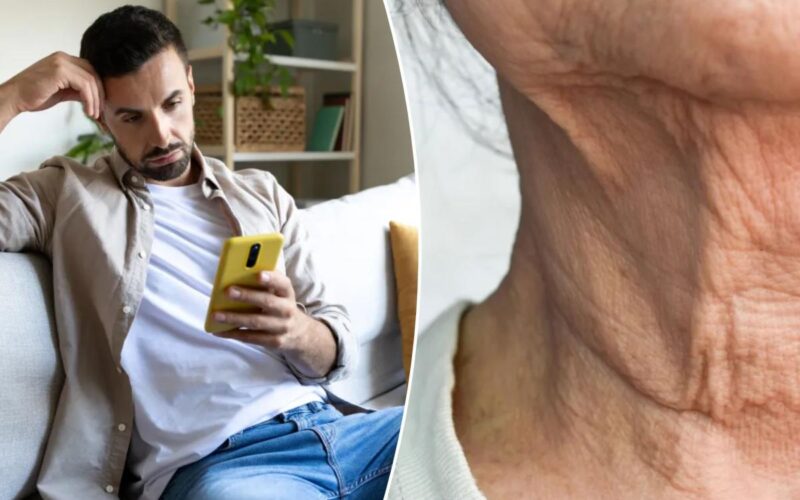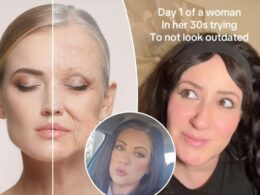All that scrolling, swiping and staring down at your device is leaving its mark.
With the average American glued to their smartphone for more than five hours a day, experts are warning that screen time is speeding up aging in a spot most of us neglect.
Dermatologists call it “tech neck,” and it’s becoming increasingly common — even in younger patients. Here’s everything you need to know.
What is tech neck?
It’s the early onset of wrinkles and sagging skin on the neck caused by repeatedly leaning the head forward while using phones, computers and other devices.
“The skin of the neck is inherently thinner and more sensitive compared to most of the body, so with age, the neck is especially vulnerable to creases and lines,” said Dr. Helen He, co-director of Mount Sinai-Clinique Healthy Skin Dermatology Center.
“I have definitely seen a growing number of patients who are concerned about laxity, crepiness, horizontal lines and creases on their neck,” she added.
While the issue tends to become more pronounced with age, He said it is “becoming more prevalent” in her younger patients as well.
Dr. Jacob Beer, a board-certified dermatologist in West Palm Beach, Fla., is seeing a similar trend. He noted that when patients come in with cosmetic concerns about their necks, the signs can vary by age.
“Typically, in middle-aged and younger patients we see the deeper front neck lines from sun damage combined with flexing to look at devices,” he said.
Can you prevent tech neck?
Hope isn’t lost. He recommends being mindful of posture — bringing your screen up to eye level rather than bending the neck to look downwards — which will improve tech neck and decrease muscle tension. Skincare can also make a difference.
“A gentle cleanser, hydrating moisturizer and sunscreen are a must,” she said. “Other helpful topical ingredients include retinoids, peptides, hyaluronic acid, and antioxidants such as vitamin C and E.”
Beer also highlighted the importance of sunscreen on the neck to prevent premature aging.
“We constantly see patients who have a different skin color on their faces where they typically remember to apply sunscreen compared to their necks,” he said, recommending SPF 30 or higher.
Also treat any conditions like eczema, which can damage the skin barrier and make lines look worse.
Can you treat tech neck?
Skincare and sun protection are the “cornerstones” of prevention and treatment, said He, but there are in-office procedures that help too.
“These include devices that use ultrasound or radiofrequency technology to tighten the skin and induce the production of new collagen and elastin, making them highly effective treatments for sagging and crepiness of the neck,” He said.
Beer frequently uses laser treatments in his practice, with the ablative carbon dioxide laser among his favorites.
For those seeking a less invasive approach, Beer said a superficial chemical peel has minimal downtime but provides more subtle results.
In patients with prominent neck lines caused by musculature, He uses neuromodulators such as Botox to relax the muscles.
How else are screens aging our skin?
“I’m certainly seeing more prominent etches in periorbital wrinkles, or crow’s feet, as well as deeper elevens or glabellar wrinkles from patients squinting at screens,” Beer said.
Beyond posture and facial expressions, the devices themselves may be contributing to premature aging.
“In addition to UV rays, we now understand that other wavelengths of light, such as blue light from screens, are also responsible for contributing to signs of skin aging and hyperpigmentation,” He said.
“Importantly, this affects individuals of all skin types, including those with darker skin tones.”
Blue light can also disrupt sleep, which may lead to dark circles, puffiness, and decreased collagen repair.
“For those who spend prolonged periods looking at screens, I recommend using a tinted mineral sunscreen with pigmented iron oxides that provides added protection against blue light,” He said.
“These protective measures will delay and mitigate signs of aging in the delicate neck area.”








